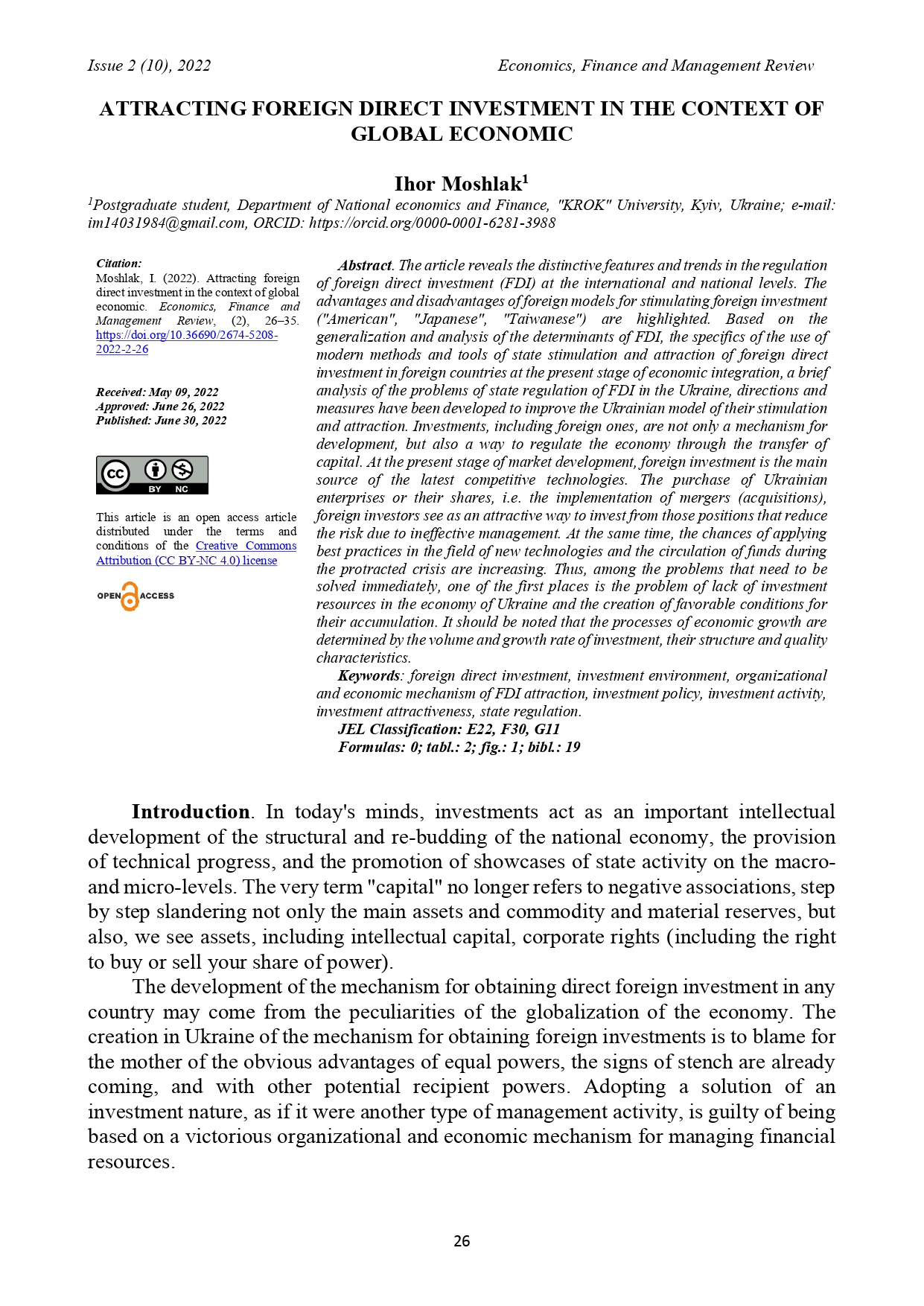ATTRACTING FOREIGN DIRECT INVESTMENT IN THE CONTEXT OF GLOBAL ECONOMIC
DOI:
https://doi.org/10.36690/2674-5208-2022-2-26Keywords:
foreign direct investment, investment environment, organizational and economic mechanism, investment policy, investment attractivenessinvestment attractiveness, state regulationAbstract
The article reveals the distinctive features and trends in the regulation of foreign direct investment (FDI) at the international and national levels. The advantages and disadvantages of foreign models for stimulating foreign investment ("American", "Japanese", "Taiwanese") are highlighted. Based on the generalization and analysis of the determinants of FDI, the specifics of the use of modern methods and tools of state stimulation and attraction of foreign direct investment in foreign countries at the present stage of economic integration, a brief analysis of the problems of state regulation of FDI in the Ukraine, directions and measures have been developed to improve the Ukrainian model of their stimulation and attraction. Investments, including foreign ones, are not only a mechanism for development, but also a way to regulate the economy through the transfer of capital. At the present stage of market development, foreign investment is the main source of the latest competitive technologies. The purchase of Ukrainian enterprises or their shares, i.e. the implementation of mergers (acquisitions), foreign investors see as an attractive way to invest from those positions that reduce the risk due to ineffective management. At the same time, the chances of applying best practices in the field of new technologies and the circulation of funds during the protracted crisis are increasing. Thus, among the problems that need to be solved immediately, one of the first places is the problem of lack of investment resources in the economy of Ukraine and the creation of favorable conditions for their accumulation. It should be noted that the processes of economic growth are determined by the volume and growth rate of investment, their structure and quality characteristics.
Downloads
References
Akhmetzyanova, T.L. (2010). Analysis of domestic and foreign investment experience: models of foreign investment policy. Bulletin BIST. # 5.
Bartels Frank, L. (2009). FDI Policy Instruments: Advantages and Disadvantages. Strategic Research and Regional Analyses Unit. UNIDO. S. A. de Crombrugghe. Associate Economic Affairs Officer. UNCTAD. Vienna. Electronic text data. URL: http://www.unido.org/fileadmin/user_media/Publications/RSF_DPR/WP012009_Ebook.Pdf
Fetisov, G.G., Oreshin, V.P. (2006). Regional economy and management. M.: INFRA-M.
лForeign Direct Innovation. (2011). The effect of FDI on innovation in the UK and what to do about it. NESTA. URL: http://www.nesta.org.uk/library/documents/FDI.Pdf.
IMF. Balance of Payments Manual. 6-th ed. Washington DC: IMF (2009). URL: http://www.imf.org/external/pubs/ft/bop/2007/pdf/bpm6.pdf
Kochemasova, A.V. (2013). World experience in attracting foreign direct investment in the context of economic globalization. URL: http://www.cepd.gov.tw/encontent/m1.aspx?sNo=0014259
Michael, D., Bodkin, Ronald, G., Hsiao, Cheng. (1996). Econometric models, techniques, and applications. London Prentice-Hall International, Inc.
Ratnayake, R. (2010). Regional mechanisms for attracting FDI and other long-term private investment towards inclusive and sustainable investment in Asia and the Pacific. UNESCAP. Expert Group Meeting on Regional Cooperation on Financing for Development. 15–16. New York. URL: http://www.un.org/esa/ffd/msc/regionalcooperation/PPT/Ratnayake.Pdf
Rumyk, I. (2019). A Strategy for financial support for food production. Science Notes of KROK University, 4 (56), 64-73. URL:https://doi.org/10.31732/2663-2209-2019-56-64-73
Rumyk, I. (2020), Rozvytok finansovoho sektoru: stan, finansova inkliuziia, viziia ta stratehiia dii [Financial sector development: status, financial inclusion, vision and strategy], Sotsialno-ekonomichni ta pravovi aspekty rozvytku suspilstva [Socio-economic and legal aspects of society development], “KROK” University, Kyiv, pp. 132-145.
Willem, D. (2006). Foreign Direct Investment and Development: An historical perspective. Background paper for World Economic and Social Survey for 2006. Commissioned by UNCTAD. URL: www.odi.org.uk/resources/docs/850.pdf
World Investment Report (2011). "Ways of organizing non-equity international production and the development of UNCTAD". URL: http://www.un.org/ru/development/surveys/docs/investments2011.pdf.
Vasileva, М.V. (2009). Macro-level parameters and guidelines for the implementation of the concept of socio-economic development of Russia. National interests: priorities and security. №17.
Vasilieva, M.V., Maliy, N., Perekrestova, L.V. (2008). Financial policy. Rostov-on-Don: Phoenix.
Zubchenko, L.A. (1993). Modern theories of foreign economic relations. Final report on the results of expert work on topical issues socio-economic strategy for the period up to 2020-2030 Strategy: a new model of growth - a new social policy.
The Global Competitiveness Report 2019. WEF. URL: http://www3.weforum.org/docs/WEF_TheGlobalCompetitivenessReport2019.pdf.
World Economic Outlook (2021). URL: https://www.imf.org/en/Publications/WEO/weo-database/2021/April/.
Mihus, I.P., Kochanova, D.D. (2013). International Scientific and Practical Conference "Prospects of management activities of business entities in the context of economic security". URL: http://eprints.cdu.edu.ua/98/1/%D0%BA%D0%BE%D0%BD%D1%84%D0%B5%D1%80%D0%B5%D0%BD%D1%86-29-31.03.2013.pdf#page=200
Statistical Yearbook of Ukraine (2021). URL: http://ukrstat.gov.ua/druk/publicat/kat_u/2021/zb/11/Yearbook_2020.pdf
Rumyk, I.I. (2020). Food security of the state: questions of theory, methodology and practice: monograph. Kyiv: University of Economics and Law "KROK", 420 p. [in Ukrainian].
Pylypenko, O., Matviienko, H., Putintsev, A., Vlasenko, I., Onyshchuk, N. Government tax policy in the digital economy. Cuestiones Políticas. 2022-03-07. DOI: 10.46398/cuestpol.4072.15

Downloads
Published
How to Cite
Issue
Section
License

This work is licensed under a Creative Commons Attribution-NonCommercial 4.0 International License.








